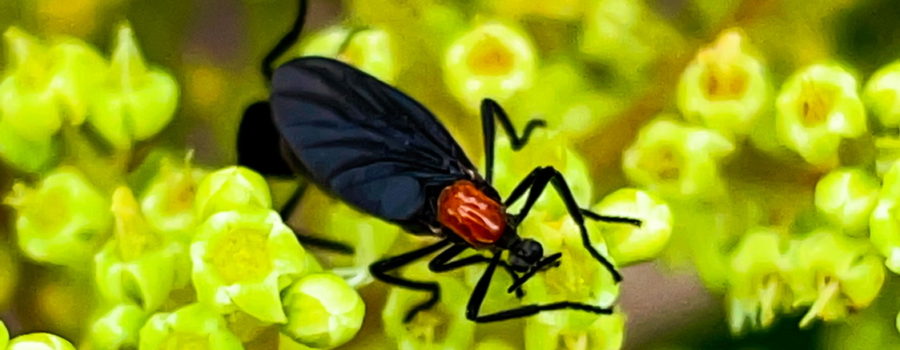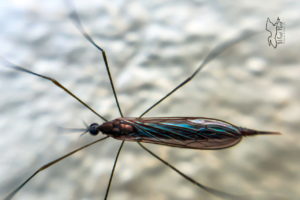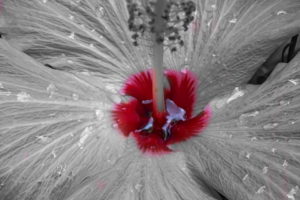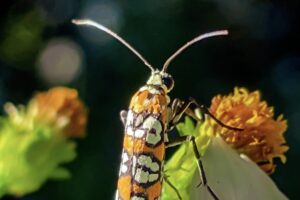Lovebugs: A Pain for Motorists, but Great for the Environment

You can’t write a blog about Florida wildlife that includes insects and not eventually write something about the lovebug (Plecia nearctica). Twice a year these little bugs swarm here in Florida; once in the spring in April or May and again in the fall between September and October. When this happens, these bugs are chemically attracted to motor vehicle exhaust and fumes put off by warm asphalt, and they swarm the state’s highways. In small numbers they are just a minor inconvenience, but larger swarms can cause overheated radiators and difficulty seeing out of bug smeared windshields. On older cars they can also cause damage to the paint, especially if allowed to bake on in the sun. I don’t think there is anyone who lives in Florida or who has driven through here this time of the year who hasn’t wondered why lovebugs exist, and what they do besides making driving difficult.

Well, I have certainly wondered that myself many times, especially when I was younger and traveled all over the state doing vaccination clinics. There were many highway and turnpike miles put on the old truck, and many gallons of windshield cleaner used during those days! It was back then that I took it on myself to learn a little more about lovebugs, because I knew they must have done something besides mess up cars and mate! And low and behold, yes they do! It turns out that they actually have a pretty important role in helping to break down decaying plant matter and recycling the nutrients back into the environment. It turns out that lovebugs are actually a type of march fly (I wasn’t sure what type of bugs they were, but I wouldn’t have guessed flies!) that is native to South America. In the late 1800’s they began to expand their range north into Central America and Mexico, and eventually into the Gulf Coast states of the United States. They can now be found in all the Gulf Coast states and along the Atlantic Coast as far north as North Carolina.

It turns out that the obnoxious swarming adults that are attracted to the highways are only a very short part of the lifecycle of this interesting insect. Depending on the source you read, adult lovebugs live between 3 and 7 days. During that time they swarm as part of the process of finding mates. Once mating begins, the bugs stay attached to each other for 2-3 days or sometimes longer until the female’s eggs are fully fertilized. After they separate, the female lays her eggs in the moist soil under downed leaves and other decaying organic matter. Shortly thereafter she dies. Occasionally, both males and females will mate a second time, but it is usually a one shot deal. While the two insects are attached to each other they will continue to fly around and to feed, which leads us to their second use in nature. They feed on flower nectar, so the adults function as pollinators!

The eggs of the lovebugs hatch out after just a few days, and it is the larvae that then feed on plant material and assist in the process of recovering the nutrients. They are particularly effective at eating and removing the thatch from lawn grasses, allowing better air flow to the live plants and recycling the nutrients back into the soil. Being flies, it’s not surprising that the larvae resemble maggots. The spring generation tends to stay in the larval stage over the summer months (approximately 120 days or so), while the fall generation overwinters as larvae until the spring flying season (approximately 240 days). During that entire time, the larvae are voraciously eating and storing energy for their short adulthood. When the conditions become right (temperature and moisture are most important) the larvae all molt into adults, and the swarms are born.

I have to say that since learning more about the lovebugs, I have developed a better appreciation for them. It’s still annoying to have a windshield smeared with them (and of course that’s when the washer fluid runs out!), but now I know that they really do serve a purpose in nature. That plus the fact that their black and red coloring isn’t unattractive and the fact that they don’t bite or cause any other serious damages, made me see them in a new light. Hopefully, it can do the same for you, too!
If you are drawn to beautiful nature photography and artwork along with informative and entertaining nature and animal related content, then this blog is for you! Just sign up below and we will deliver it to your inbox daily. But no spam or ads, I promise!





Recent Comments